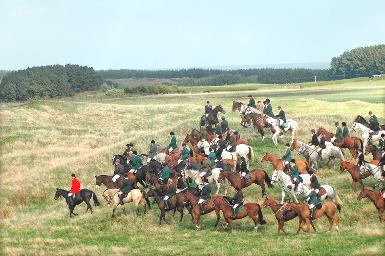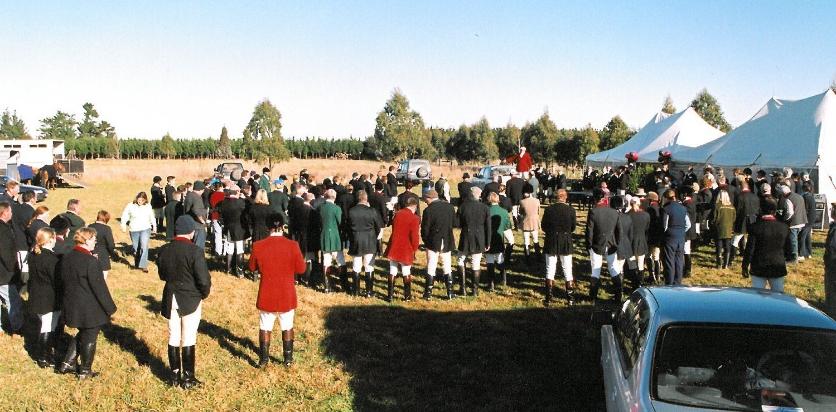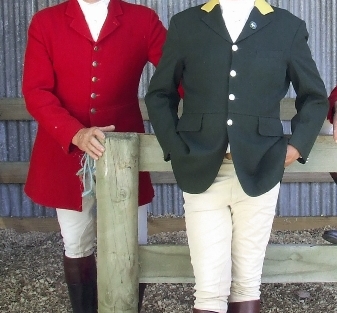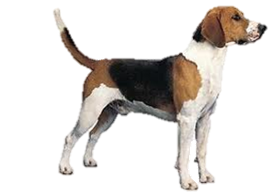
The Master
The Master is ultimately responsible for the running of the Hunt, the Kennels and the hunt day. The Master's word is final on all occasions.
The Master will have approved the fixture card and on hunt day will decide, in consultation with the Huntsman, how country will be drawn and when the Huntsman will blow for home.
The responsibility of the hunt day rests with the Master whose role along with the Huntsman is to provide the best sport possible and maintain the well being of the livestock and the property hunted. The proven and practical traditions of hunting in regard to procedure and etiquette are adhered to. For example riders are expected to attend the breakfast at the conclusion of the day to be present when the Master thanks the ever generous Landowners for sharing their country and making the sport possible.

The Egmont Wanganui Hunt hosted one of the Rangitikei Hunt's Jubilee hunts 2006

In 2005 Christchurch Hunt celebrated 125 years of hunting, pictured here is Master Dave McConchie thanking the landowners during the Hunt breakfast at the Maleys Charring Cross property.
The Huntsman cares for the hounds and maintains the Kennels and the Hunt property.The Huntsman is employed by or contracted to the Hunt. The Huntsman is responsible for the welfare of the hounds at the Kennels including their exercise program prior to the season ensuring they are fit and ready to hunt. The Huntsman controls them in the field on hunt day and uses verbal and horn commands to achieve this.
The Whippers In
There are normally two "Whippers-In" on a hunt day and their role is to assist the Huntsman to control the hounds. This is achieved by riding the outskirts of the hounds and being ready to move the pack on in the direction desired by the Huntsman. The Huntsman conveys his wishes to the hounds and thus the Whippers-In by voice and horn commands.
The Whippers-In are responsible only to the Huntsman and Master.
The Field
The Field consists of the mounted followers and is controlled by the Master who rides at the head of the Field with the Huntsman and Whippers-In in front. The Masters role on the day is to keep the Field in touch with hounds at the same time ensuring the Huntsman has room to work them and not have the hounds "over-run" by the Field.
The Master is responsible for the field's care of the property by avoiding areas of concern to the Landowner.
The Secretary
The Secretary is responsible to the Master for the day to day administration of the Hunt, communicating with members, attending to correspondence, paying accounts, subscriptions etc. Many Hunts have a Field Secretary whose duties vary from Hunt to Hunt which may include collecting subscriptions, days riding fees, caps and in some cases is responsible for certain properties
The secretary is in general the only other person retained by a Hunt on a professional basis.
Hunting Etiquette
Hunting traditions have evolved over the centuries to bring them in line with the changing times or country characteristics. However in reality hunting continues to be practiced internationally following the original basic principles.
Hunting etiquette is the 'unwritten code' associated with the sport and encompasses those tried and true traditions of procedure, dress and conduct that have been found to be practical to ensure the hunt day is organised, safe, enjoyable and in the best interest of the sport.
These traditions include simple courtesies. On arrival to a hunt (referred to as a meet) it is customary to greet the Master with “Good Morning Master”. It is also expected that when Landowners are present they are acknowledged by members with greetings and thanks.
As in all sports there is terminology associated with hunting. For example ‘Hunts’ are referred to as such and not as ‘Hunt Clubs’. ‘Hounds’ are not called ‘dogs’ and they ‘speak’ or ‘give tongue’ and do not bark. This is referred to as ‘music’ and not barking.
Dress
Dress on the hunt field is largely traditional and essentially practical and is based on safety and comfort.
Each Hunt has registered colours with the NZ Hunts’ Association. This refers to the Hunt coat and collar colour and is distinctive for each Hunt. In most Hunts the Master and Huntsman wear a red coat, practically, this is very useful as it makes them distinctive in the field. There are many traditions associated with dress, one is the number of buttons that members, officials, Masters and Huntsmen wear.
And gentlemen and ladies wear different coloured breeches and stocks.

Master & Huntsmans red coat on L). Traditionally Masters have four buttons and Huntsmen have five (Past Masters may wear four buttons). Masters & Huntsman's coats are square cut at the bottom. Members should have rounded cut at the bottom. A hunting coat has one back vent.
Hounds
There is etiquette associated with counting hounds. Hounds were often coupled together to allow better control when being walked to meets, thus hounds are referred to as “couples’. We therefore refer to 33 hounds as 16 ½ couple.
There are few experiences more exhilarating than the sight and music of a pack of hounds in ‘full cry’ with a field in hot pursuit.
The NZHA Official Description of the Harrier Hound

Characteristics: An active, well-balanced, well-muscled and good boned hound, full of strength and quality. Fearless, though of a kindly nature in or out of the pack. When being shown should exhibit presence and quality. Doghounds should show masculinity and bitches be feminine and ALL should show presence.
Head: Of medium size with a good, bold forehead. Stop slightly pronounced with a straight and powerful muzzle.
Bite: Must be even and regular, with a scissor bite – the upper teeth closely overlapping the lower teeth.
Ears: Set high, lying close to the cheek and broad.
Shoulders: Fine, well laid back and sloping well into the muscles of the back.
Legs: Forelegs straight with plenty of bone, running well down to the toes with round cat like feet and close toes.
Elbows: Points set well away from the ribs, running parallel with the body and turning neither in nor out.
Body: The back should be level and muscular and not dipping behind the withers or arching over the loins. Deep, well sprung ribs, running well back, with plenty of heart room and a deep chest.
Stern: Well set on, long and well controlled rising higher than the back without the tip being turned over too much.
Coat: Short, dense, hard and glossy.
Colour: Any hound colour.
Height: Any height within reason, the ideal being 53.5 centimetres (21 inches).